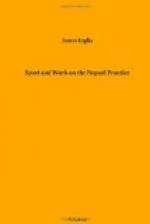On one occasion W.D. had got down beside what he thought a dead tiger, had rolled him over, and, tape in hand, was about to measure the animal, when he staggered to his feet with a terrific growl, and made away through the jungle. He had only been stunned, and fortunately preferred running to fighting, or the consequences might have been more tragic; as it was, he was quickly followed up and killed. But instances like these might be indefinitely multiplied, all teaching, that seemingly dead tigers should be approached with the utmost respect. Never venture off your elephant without a loaded revolver.
In beating for tiger, we have seen that the appearance of the kill, whether fresh or old, whether much torn and mangled or comparatively untouched, often affords valuable indications to the sportsman. The footprints are not less narrowly looked for, and scrutinized. If we are after tiger, and following them up, the captain will generally get down at any bare place, such as a dry nullah, the edge of a tank or water hole, or any other spot where footprints can be detected. Fresh prints can be very easily distinguished. The impression is like that made by a dog, only much larger, and the marks of the claws are not visible. The largest footprint I have heard of was measured by George S., and was found to be eight and a quarter inches wide from the outside of the first to the outside of the fourth toe. If a tiger has passed very recently, the prints will be fresh-looking, and if on damp ground there can be no mistaking them. If it has been raining recently, we particularly notice whether the rain has obliterated the track at all, in any place; which would lead us to the conclusion that the tiger had passed before it rained. If the water has lodged in the footprint, the tiger has passed after the shower. In fresh prints the water will be slightly puddly or muddy. In old prints it will be quite clear; and so on.
The call of the male tiger is quite different from that of the female. The male calls with a hoarse harsh cry, something between the grunt of a pig and the bellow of a bull; the call of the tigress is more like the prolonged mew of a cat much intensified. During the pairing season the call is sharper and shorter, and ends in a sudden break. At that time, too, they cry at more frequent intervals. The roar of the tiger is quite unlike the call. Once heard it is not easily forgotten, The natives who live in the jungles can tell one tiger from another by colour, size, &c., and they can even distinguish one animal from another by his call. It is very absurd to hear a couple of natives get together and describe the appearance of some tiger they have seen.




